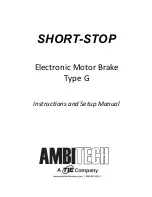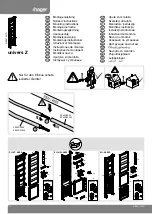
6
7.7
Option P (Braking on Demand)
For applications where a braking cycle is not always
needed when stopping the motor, refer to the wiring
diagram in Figure 7.7. This configuration will initiate a
braking cycle
only
if the braking on demand push-button
is engaged. Otherwise, the motor will coast to rest when
the regular stop push-button is engaged.
Figure 7.7
Braking on Demand
8.
ADJUSTMENTS
8.1
Description of the Adjustments
Two adjustment controls are provided within the SHORT-
STOP. These determine the amount of braking power
applied to the motor (TORQUE) and the length of time
this power is applied (TIME).
CAUTION
With high torque settings, this brake can loosen self-
tighten shaft mounted cutting tools.
Be certain that tool arbor is keyed, double nutted, or
locked very tightly.
Test locking mechanism for secure operation periodically.
These controls are single turn potentiometers, which can
be set by means of a small screwdriver (An insulated
screwdriver is recommended). Both controls are at their
minimum when turned fully counter clockwise.
DO NOT FORCE THE ADJUSTMENT PAST
THE END STOPS!
Once set for a particular application, the controls should
not have to be re-adjusted.
A red LED indicator on the circuit board is illuminated
during braking.
8.2
Setting the Adjustments
(1 ) Set TIME control (located on the logic board, to the
left of the brake LED) to mid-range
(2)
Set TORQUE control (located on the phase-shift
board, below the fuses) to minimum (Full counter
clockwise)
(3)
Turn main power ON
(4)
Turn motor ON. After full speed is reached, turn motor
OFF
(5)
Adjust TORQUE control in 1/8 turn steps to reach
desired safe braking rate. Braking action is indicated
by a slight hum of the motor.
(6)
Adjust TIME control so that braking hum stops (and
LED goes out) about one second after motor stops.
(7)
Repeat steps 4 to 6 above, until a satisfactory stopping
time is reached. The maximum tolerable stopping time
should be used.
CAUTION
AS THE MOTOR HEATS UP, THE WINDING
RESISTANCE WILL INCREASE. THIS MAY
REQUIRE A LONGER APPLICATION OF THE
BRAKING CURRENT. THEREFORE, SET THE TIME
CONTROL EITHER WITH THE MOTOR HOT, OR SO
AS TO "HANG ON" FOR ABOUT A SECOND AFTER
STOPPING A COLD MOTOR.
Applying the brake for a longer time than necessary
serves only to increase motor heating.
9.
HOW THE SHORT-STOP WORKS
9.1
Basic Concept
The principle used by the SHORT-STOP is the injection of
a controlled amount of DC (Direct Current) into an AC
motor to achieve braking. The effect in stopping can be
considered completely equivalent to that at motor startup.
The DC current in the motor stator sets up a stationary
magnetic field in which the rotor is turning. The
Control
Transformer
X1
X2
BRAKING ON START
STOP
DEMAND
OL's
3
4
M
SHORT-STOP
Terminals
M
B
SHORT-STOP
PCBoard
Terminals
Y



























